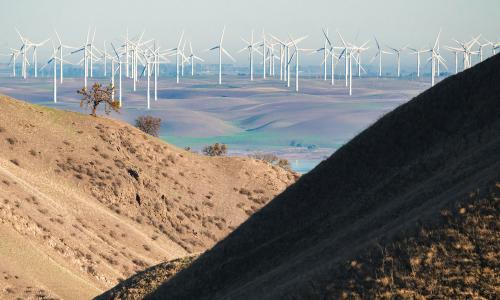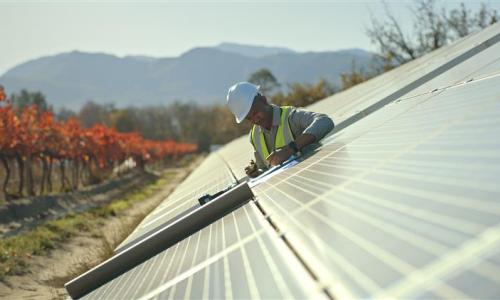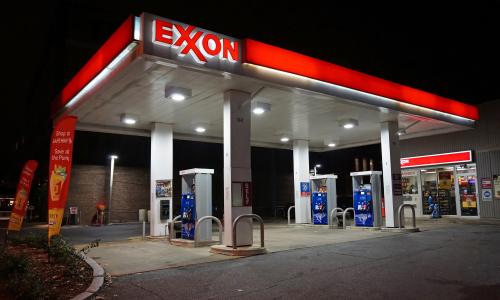Under California's landmark 2018 clean energy law, the state is mandated to source 100 percent of electricity retail sales from renewable and noncarbon resources by 2045.
This will help slash global warming emissions and pollution from the energy sector, contributing to progress toward California's climate goals. The increasing number of climate-fueled extreme weather events and growing electricity demand—both of which are stressing the state's electricity grid—underscore the urgency of reaching 100 percent clean energy in a safe and reliable manner.
Understanding California’s Transmission Development Delays and Paths to Reform
This is a condensed online version of the issue brief. The full version can be downloaded here
Introduction
Under California's landmark 2018 clean energy law,[1] the state is mandated to source 100 percent of electricity retail sales from renewable and noncarbon resources by 2045. This will help slash global warming emissions and pollution from the energy sector, contributing to progress toward California's climate goals. The increasing number of climate-fueled extreme weather events and growing electricity demand---both of which are stressing the state's electricity grid---underscore the urgency of reaching 100 percent clean energy in a safe and reliable manner (Governor's OPR, CEC, and CNRA 2019).
The electricity grid encompasses the network of infrastructure, including power generation, transmission lines, and the distribution system, that delivers electricity to houses and other end uses. Transmission lines, working with other energy infrastructure such as substations and transformers, carry electricity over long distances and are essential to the grid’s function.
The clean energy transition crucially depends on more transmission capacity in order to connect areas with power generating resources, such as solar and wind facilities, to urban centers. At the same time, electricity demand is rapidly growing as buildings and transportation sectors electrify, and new sources of demand, such as data centers, come online. The California Independent System Operator (CAISO), which operates the state’s grid, estimates that California will need an additional $45.8 billion to $63.2 billion of transmission investment to achieve its goal of a carbon-free electricity grid by 2045 (CAISO 2024).
Transmission system capacity growth has not kept pace with the growth of clean energy resources needed to meet electricity demand. This gap has resulted in grid stress, leading to rolling outages and delays to fossil fuel resource retirements. Upgrading the transmission network to facilitate more effective energy deliverability is critical to achieving a clean, modernized grid.
Securing such a grid will provide a wide range of benefits to Californians. For one, it will allow for the retirement of gas-fueled power plants, which have harmful impacts on public health, the climate, and the environment; these impacts particularly affect low-income communities and communities of color (Yang 2024). In addition, an upgraded grid will be key to meeting increasing electricity demand and to keeping the grid reliable. This means less risk of blackouts and power outages during hot summer days or when energy demand is otherwise high. Finally, it will set the foundation needed in order for customers to access affordable clean energy resources with more price stability in the long term.
However, insufficient transmission capacity has delayed the connection of a significant amount of clean energy resources to the grid. Generating resources must request to connect to the grid, and CAISO performs studies to ensure connecting resources can be smoothly integrated into the transmission system. In 2023, the CAISO interconnection queue had 185 gigawatts (GW) worth of generating resources with another 347 GW submitted for study (Millar 2024). The agency paused these requests to reform the interconnection process, which has since been implemented. Projects requesting to connect to the grid are largely solar, wind, and storage projects.
Expanding the transmission system is necessary to access the benefits of clean energy. This analysis highlights that California’s transmission projects are facing major delays, which ultimately delay these benefits reaching consumers and puts the state at risk of not meeting its clean energy commitments.
As we lay out in the following sections, California’s investor-owned utilities have not delivered the transmission buildout needed to meet state goals, nor have they fully addressed the reasons for these continued delays. Past underinvestment in the grid has led to the state approving significantly higher transmission investment in recent years. With this new approved investment underway, it is critical that transmission development reforms be implemented to move projects forward in a timely and equitable manner.
The Union of Concerned Scientists (UCS) has identified several recommendations aimed at accelerating transmission development and reducing project costs, allowing Californians to access the benefits of a clean, modernized grid.
California's Transmission System
A variety of players are involved in operating, owning, planning, and building California’s transmission network. The state’s three major investor-owned utilities (IOUs)—Pacific Gas and Electric (PG&E), Southern California Edison (SCE), and San Diego Gas & Electric (SDG&E)—own and maintain the majority of the transmission lines in the state. However, they cede operational control of these facilities to CAISO to operate the electricity grid for approximately 80 percent of California and a small part of Nevada.
CAISO leads transmission planning through its annual Transmission Planning Process (TPP), which determines which new projects will be needed in the next 10 years.[2] The transmission plan covers projects that expand the grid, such as new transmission lines or capacity upgrades to existing infrastructure. Currently, 22 percent of California’s transmission infrastructure projects are approved under CAISO’s TPP (CEC 2025). The rest are repair and replacement projects, which are initiated and developed by utilities through self-approval and not included in the TPP.
The obligation and rights to finance, build, and own projects under the TPP will generally default to the utility in that service area. Projects above 200 kilovolts (kV) or those that cross multiple service areas undergo competitive solicitation, allowing private developers to build and own these lines. Utilities and developers finance the capital and maintenance costs for these projects, and they recover these costs through a Transmission Access Charge on ratepayers’ monthly bills.
Data and Methodology
This issue brief uses multiple data sources to identify broader trends in California’s transmission development, as well as analyzes a subset of major transmission projects and the extent of delays they are experiencing.
The subset analysis evaluates the progress of development and completion of major transmission-related projects approved by CAISO from 2010 to 2021. It draws on data from CAISO’s TPP reports starting with the 2010–2011 cycle through the 2023–2024 cycle.[3]During this timeframe, CAISO approved almost 300 new projects.
Projects vastly varied in scope and cost. For this subset analysis, projects were selected if they had a cost of more than $50 million (adjusted to 2024 according to the Consumer Price Index (CPI)) and the project scope included at least one of the following: (1) new substation/substation upgrades, (2) new transmission lines, or (3) transmission line upgrades. These scope constraints were used to limit the analysis to significant investments in transmission infrastructure. Additionally, only projects approved in TPPs prior to 2020–2021 were evaluated to ensure enough time had passed to allow for development activity and changes to the development timeline to occur. These criteria resulted in 21 transmission projects for analysis.[4]For more information on the data set, refer to Appendix.
Each selected project was then assessed based on the initial estimated completion date compared to the actual time it took to complete. If the project was still under development, the most recent estimated completion date was used.
The Transmission Project Reviews (TPRs) (CPUC 2025), which include additional data reported by the state’s IOUs on their transmission projects, were the primary source used to determine explanations for project delays. These reviews provide reasons for the change of in-service date when the projected or current in-service date varies more than six months from the original estimated in-service date (see Table 2 for full list of options from TPRs). Supplementary web searches were used when needed. Data from the TPRs were also aggregated to identify broader trends in project delays.
Results and Discussion
The data reveal several broad trends about transmission investments that provide useful context. As noted in Figure 1, there has been a large increase in approved project costs within the past three TPP report cycles. By contrast, investments were comparatively low in the 2014–2015 to the 2020–2021 cycles. Underinvestment in grid expansion during this period has resulted in insufficient transmission capacity that is now making it more difficult for clean energy projects to connect to the grid at the pace needed to achieve state targets and meet growing electricity demand.
Most of the CAISO-approved projects during the reviewed period have been reliability-driven (83 percent). However, in the past two cycles, policy-driven projects, which are intended to progress California’s clean energy goals, have increased significantly, accounting for 39 percent of the total. Upgrading the grid will take intentional efforts to access areas of high clean energy resource potential and connect them with major load centers. Regional zones within California often have transmission constraints that prevent the delivery of more renewable resources, which are needed to bolster local grid reliability. Given the large backlog of clean energy projects in the interconnection queue, transmission projects that unlock this clean energy will be particularly important for achieving the state’s clean energy goals.
How Long Are Projects Being Delayed?
The subset analysis of 21 projects highlights that it is common for projects to experience major delays from their estimated timeline. The results are summarized in Table 1. On average, these projects have taken an additional 6.1 years to complete, more than double the original estimated completion time. At the high end, two projects have taken an additional 11 years, almost four times the original estimated time, and neither of these projects is finished yet. Of the 10 transmission infrastructure projects that have been completed, none were completed in the original estimated time.
Additionally, three projects were canceled and two were significantly rescoped many years after initial approval. The transmission network needs to be comprehensive and coordinated, and these major changes can have a rippling impact on other projects and create uncertainty in other aspects of the grid transition, such as bringing new resources online. However, the cancelations and rescopes occurred in 2018 and 2019. Since that time, state agencies have implemented stronger collaboration processes for coordinating more aspects of the grid such as demand forecasts, the interconnection process, permitting reform measures, and resource planning. These reforms may help transmission planning and development move forward more smoothly.
What Is the Impact of These Delayed Projects?
This analysis intends to highlight the significant delays in transmission projects, which ultimately translate to delayed benefits to customers. These delayed benefits include the retirement of polluting fossil fuel plants, access to lower-cost clean energy, and the improved electricity reliability gained through a diverse portfolio of clean energy resources and interregional coordination.
For example, in the summer of 2020, CAISO implemented rolling blackouts as the state experienced an extreme heat wave that led to surging electricity demand. The CAISO investigation into the incident revealed, among other reasons, that “transmission constraints ultimately limited the amount of physical transfer capability into the CAISO footprint” (CAISO, CPUC, and CEC 2021). Although imports were available during this time of grid stress, there was insufficient transmission to bring the electricity to the CAISO balancing authority area.
Recent summer risk assessments by the North American Electric Reliability Corporation note that the California grid experiences heightened reliability risks due to extreme weather events, such as droughts, wildfire, and heat waves (NERC 2025). A comprehensive transmission network is fundamental to facilitating a diverse portfolio of clean energy resources, including access and coordination with other regions, for a reliable and resilient grid. Ensuring that transmission is brought online as planned is critically important amid these growing climate events.
This analysis did not assess the impact that project delays have on project costs, and, in turn, the impact to ratepayers, although that is an important area for further work.
Why Are Projects Being Delayed?
The full data from the TPRs show that reasons for CAISO-approved project delays varied across the IOUs and are presented in Table 2. While the list of reasons for IOUs to select from is consistent across reports, there are no strict definitions of these categories in the TPR process. Reporting is up to utilities’ discretion, possibly making cited reasons inconsistent across IOUs and interpretation of these results difficult based on limited supplemental information.
For PG&E, California’s largest utility, “prioritization” of other investments and projects was the primary reason for project delays. In the subset analysis, seven of PG&E’s 14 projects experienced “prioritization” delays that added an average of 8.4 years to project time, over triple the original estimated completion time.
According to PG&E (CAISO 2023), the deprioritization of a significant number of the CAISO TPP-approved transmission projects has been driven by two main factors. The first is the Community Wildfire Safety Program in 2018, which has redirected funds to projects related to wildfire safety. As wildfires increasingly devastate California (Dahl et al. 2023), it is critically important to ensure that grid infrastructure is wildfire safe. The second is inflation and supply chain delays, which have increased the cost and time of PG&E’s work plan.
However, PG&E’s recent record-high profits call into question how the utility’s financial resources are being allocated (EWG 2025). Transmission projects being developed by PG&E are seriously delayed, preventing ratepayers from accessing low-cost clean energy while they simultaneously bear the costs of these high shareholder profits.
Regardless of the reason for project reprioritization, the record shows that PG&E is failing to oversee adequately the transmission buildout needed to meet state reliability and clean energy goals. According to the utility’s TPR data, 61 percent of its CAISO-approved projects are experiencing delays, and 73 percent of these delayed projects cited “prioritization” as the reason for delay. Allowing PG&E to continue deprioritizing these critical infrastructure projects contributes to the cascading delays in grid modernization. Ultimately, ratepayers and customers will suffer from delayed access to more affordable clean energy.
SCE and SDG&E similarly had high rates of CAISO-approved projects being delayed (62 percent of SCE projects and 76 percent of SDG&E projects). For SDG&E, the most common project delay reason was “permitting,” cited in 63 percent of projects. This was followed by “construction delays” (26 percent), “land rights” (21 percent), and “prioritization” (21 percent). SCE’s most cited reasons were “prioritization” (24 percent) and “permitting” (21 percent).
SCE provides more information on its decisionmaking process in project prioritization, although notes that it does not “currently maintain an enterprise-wide quantitative mechanism that scores and prioritizes all programs and projects.” However, the utility offers descriptions of the prioritization process for categories of projects (for example, transformers) to provide some insights.
SDG&E notes that many projects have experienced permitting delays as a result of local communities raising concerns and also of challenges meeting the California Environmental Quality Act (CEQA) requirements. The permitting process and subsequent timeline for approval “can vary greatly based on a multitude of factors including project location, project specific environmental issues, lead/other agency resources, and public participation.” Delays occur at different points in the permitting process and often vary from project to project. A throughline is that permitting agencies need proper resources to assess and adjudicate the various issues that arise during permitting processes in a timely manner.
Recommendations
Expand Projects Eligible for Competitive Solicitation: The development rights for most CAISO-approved transmission projects default to the IOU. This is because current CAISO rules enable only projects above 200 kV or those that cross multiple service areas to undergo competitive solicitation. As a result, only 5 of 71 new projects were open to competitive solicitation in the recent 2022–2023 and 2023–2024 TPP cycles. Allowing more projects to be eligible for competitive solicitation can reduce project costs and improve project timelines as utilities work through their existing backlogs of projects (PAO 2023). With the incoming surge of new transmission investment, opening more projects to competitive solicitation can bring in more developers and resources to get this infrastructure online. It is already within CAISO’s authority to expand which projects are eligible for competitive solicitation.
Increase Agency Resources and Capacity for Permitting Processes: Permitting for transmission projects is a multistep process that involves projects obtaining all necessary approvals, undergoing environmental review, and offering opportunities for public engagement. The California Public Utilities Commission is the lead agency for CEQA reviews for most transmission projects, although agencies such as the California Energy Commission, CalTrain, California Department of Fish and Wildlife, State Lands Commission, and counties may also have lead or supporting roles. As transmission investments increase, public agencies across the federal, state, and local levels need staff capacity, expertise, and resources to properly oversee CEQA review and other aspects of the permitting process. Ensuring agencies can hire and retain staff with expertise and experience in environmental reviews, as well as early Tribal consultation and community engagement, is critical to moving permitting processes forward in a timely and coordinated manner while maintaining a high level of integrity in the process.
Implement Public Transmission Financing Pathways: Public transmission financing, such as wholly public or public–private partnership models, can provide lower-cost financing options for transmission infrastructure (Alex, Elkind, and Peters 2024). Amid IOUs’ constrained financial resources and the continued reporitiorization of projects, public financing can be a mechanism to push critical transmission infrastructure forward. Public financing can access low-cost debt and additional resources to develop transmission projects when the IOUs’ progress has been lacking. An important additional benefit is that public financing has high potential cost savings compared to the current default financing option (CATF and Net-Zero California 2024), in part because the state does not require the return on equity (profits) that IOUs receive. These savings could reduce rates, thereby addressing a currently increasing burden on all Californians but particularly on low-income households.
Accelerate Clean Grid Technology Solutions: While new transmission infrastructure will be needed to reach the state’s energy goals, there are complementary technology solutions that can enhance existing infrastructure. For example, grid-enhancing technologies and advanced reconductoring (for example, replacing power lines with advanced conductors that increase line capacity) can facilitate increased transmission capacity faster and more affordably. Storage as a transmission asset can work in tandem with transmission by managing power flows through the grid and improving grid flexibility. Leveraging surplus interconnection can allow more complementary generating resources to connect to the grid within the existing transmission network capacity. While the state has begun to implement some of these technology solutions, there remains additional work to do in the regulatory space, as well as coordination with the utilities and CAISO on implementation and operation, to ensure these resources are prioritized in grid planning so they develop at scale quickly.
Prioritize Transmission Infrastructure That Unlocks Clean Energy: In the past three TPP cycles included in this analysis, new policy-driven transmission projects accounted for 36 percent of approved projects. In the 11 prior TPP cycles, policy-driven transmission accounted for only less than 1 percent of approved projects. The effort to identify and develop the critical transmission infrastructure needed to meet the state’s clean energy goals is improving. Additional assessments should be conducted to determine which projects have the most potential to get new clean energy generation online. By prioritizing these transmission projects, the state will be able to interconnect greater amounts of clean energy resources that have long been stuck in the interconnection queue. This will not only help the state meet its climate and clean energy commitments, but also improve local air quality in environmental justice communities by reducing the need for polluting gas plants.
Authors
Vivian Yang is an energy analyst in the UCS Climate and Energy Program.
Acknowledgments
This analysis was made possible by the generous support of Energy Foundation and UCS members.
The author would like to thank the following people for their thoughtful review of this issue brief: Alexis Sutterman, Brightline Defense; Maia Leroy, CEERT; Michael Colvin, Environmental Defense Fund; and reviewers at American Clean Power.
The author is also grateful to colleagues at UCS who were instrumental throughout the process of researching, writing, editing, and production of this issue brief, including Daniel Barad, Leslie Brunetta, Michele Canales, Juliet Christian-Smith, Jeff Deyette, Brenda Ekwurzel, Melissa Finucane, Sam Gomberg, Mike Jacobs, Daela Taeoalii-Tipton, Heather Tuttle, Bryan Wadsworth, and Claudia Ward-de León.
Organizational affiliations are listed for identification purposes only. The opinions expressed herein do not necessarily reflect those of the organizations that funded the work or the individuals who reviewed it. The Union of Concerned Scientists bears sole responsibility for the report's content.
References
Alex, Ken, Ethan Elkind, and Grayson Peters. 2024. Improving Transmission Financing in California. Berkeley, CA: Berkeley Law Center for Law, Energy, & the Environment. https://www.law.berkeley.edu/wp-content/uploads/2024/10/Improving-Transmission-Financing-in-California-CLEE.pdf
CAISO (California Independent System Operator). 2023. "Stakeholder Comments." Accessed June 13, 2025. https://www.caiso.com/documents/iso-responses-to-comments-transmission-development-forum-oct25-2023.pdf
CAISO (California Independent System Operator). 2024. "2024 20-Year Transmission Outlook." Accessed June 13, 2025. https://www.caiso.com/documents/2024-20-year-transmission-outlook-jul-31-2024.pdf
CAISO (California Independent System Operator). 2025. "Interconnection Queue Reports." Accessed June 13, 2025. https://www.caiso.com/library/interconnection-queue-reports
CAISO, CPUC, and CEC (California Independent System Operator, California Public Utilities Commission, and California Energy Commission). 2021. Root Cause Analysis: Mid-August 2020 Extreme Heat Wave. Folsom, CA. https://www.caiso.com/Documents/Final-Root-Cause-Analysis-Mid-August-2020-Extreme-Heat-Wave.pdf
CATF (Clean Air Task Force) and Net-Zero California. 2024. Wired for Savings. Boston and Sacramento. https://cdn.catf.us/wp-content/uploads/2024/10/31145139/wired-for-savings.pdf
CEC (California Energy Commission). 2025. "Tracking and Approving Transmission Projects." Accessed June 13, 2025. https://www.energy.ca.gov/programs-and-topics/topics/california-transmission-system/tracking-and-approving-transmission
CPUC (California Public Utilities Commission). 2025. "Transmission Project Review Process." Accessed June 13, 2025. https://www.cpuc.ca.gov/industries-and-topics/electrical-energy/electric-costs/transmission-project-review-process
Dahl, Kristina, Carly Phillips, Alicia Race, Shana Udvardy, and J. Pablo Ortiz-Partida. 2023. The Fossil Fuels Behind Forest Fires. Cambridge, MA: Union of Concerned Scientists. https://www.ucs.org/resources/fossil-fuels-behind-forest-fires
EWG (Environmental Working Group). 2025. "PG&E Record 2024 Profits Highlight CPUC Failure to Protect Ratepayers." February 14, 2025. https://www.ewg.org/news-insights/statement/2025/02/pge-record-2024-profits-highlight-cpuc-failure-protect-ratepayers
Governor's OPR, CEC, and CNRA (Office of Planning and Research, California Energy Commission, and California Natural Resources Agency). 2019. California's Fourth Climate Change Assessment, Statewide Summary Report. Sacramento. https://www.energy.ca.gov/sites/default/files/2019-11/Statewide_Reports-SUM-CCCA4-2018-013_Statewide_Summary_Report_ADA.pdf
Millar, Neil. 2024. "Decision on Interconnection Process Enhancements 2023 - Track 2." Memorandum to ISO Board of Governors, June 6. Folsom, CA: CAISO. https://www.caiso.com/documents/decision-on-interconnection-process-enhancements-track-2-memo-jun-2024.pdf
NERC. 2025. "Reliability Assessments." NERC. https://www.nerc.com/pa/RAPA/ra/Pages/default.aspx.
PAO. 2023. "Competitive Solicitation in Transmission Line Development Lowers Ratepayer Costs and Decreases Delays." The Public Advocates Office. https://www.publicadvocates.cpuc.ca.gov/-/media/cal-advocates-website/files/press-room/reports-and-analyses/230609-caladvocates-increasing-competitive-solicitation-in-transmission.pdf.
Yang, Vivian. 2024. "Reliance on Gas Power Plants Fuels Inequity." The Equation (blog). January 10. https://blog.ucs.org/vivian-yang/reliance-on-gas-power-plants-fuels-inequity/
Endnotes
-
The 100 Percent Clean Energy Act of 2018. PUC § 399.11, 399.15, 399.30, 454.53 (2018).
-
CAISO moved to a 15-year planning horizon beginning in the 2024--2025 planning cycle, which was not included in this analysis.
-
CAISO does not archive prior TPP reports, although there are projects that were approved in these prior years that are still under development. These projects were not included in the analysis.
-
Most approved projects did not meet the subset criteria because they were below the $50 million threshold. The 21 projects analyzed represent approximately 33 percent of the approved investment during this time.
This is a condensed online version of the issue brief. The full version can be downloaded here
Downloads
Citation
Yang, Vivian. 2025. Understanding California’s Transmission Development Delays and Paths to Reform. Cambridge, MA: Union of Concerned Scientists. https://www.ucs.org/resources/understanding-californias-transmission-development-delays-and-paths-reform



